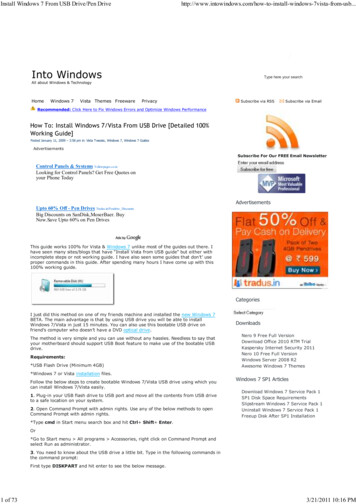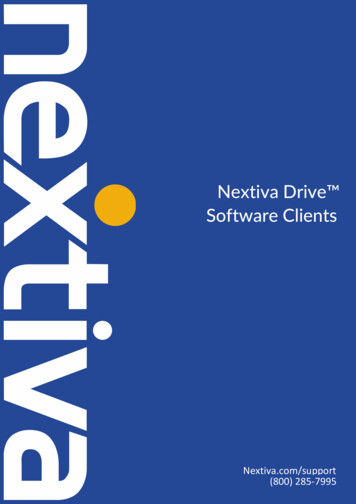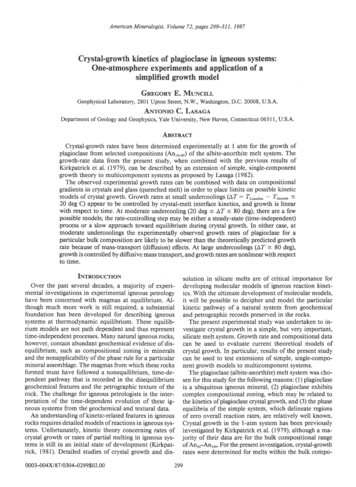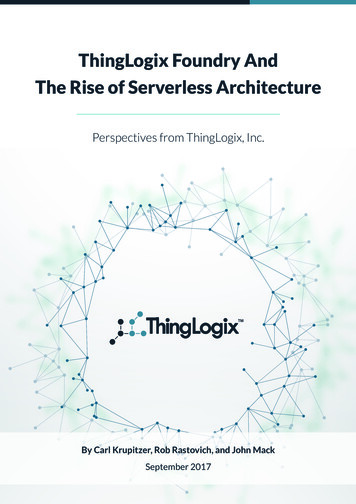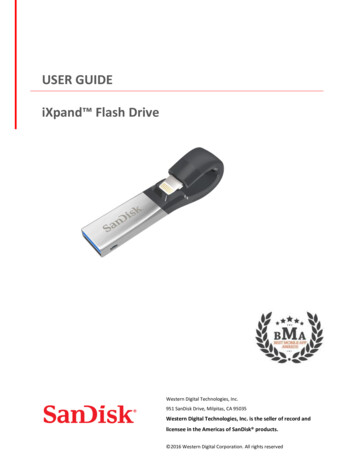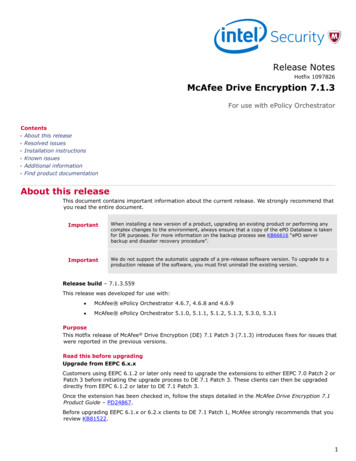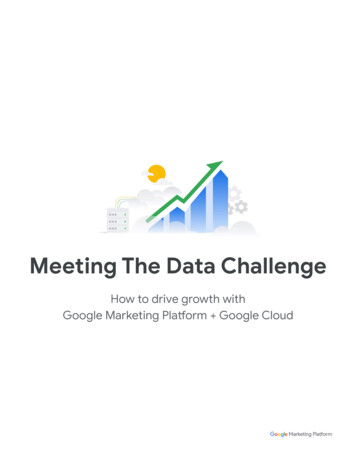
Transcription
Meeting The Data ChallengeHow to drive growth withGoogle Marketing Platform Google CloudMarketing Platform
MEETING THE DATA CHALLENGEForeword01 Smarter, faster marketing02 Prepare for the future by anticipating customer needs03 Better together: Google Marketing Platform Google CloudUnderstand your customersTrendspotting: Get a bird’s eye view of customer behaviorSegmentation: Generate audiences at scaleCreate better experiencesSentiment monitoring: Align your marketing around customer experiencePersonalization engine: Customize what your customers seePredict marketing outcomesPurchase Prediction: Predict whether customers will purchase in the futureLifetime Value Prediction: Adapt your marketing to predicted customer lifetime value04 Steps to get startedBuild a technology roadmapInvest in your first-party dataMove data into BigQueryUse machine learning in Google CloudBring Cloud insights to Google Marketing PlatformActivate those insightsConclusionMarketing Platform2
Foreword:The data challengeThe consumer journey is becoming increasingly complicated. People are changingthe way they purchase goods and services compared to just a year ago. In the UnitedStates, a recent survey found that 83% of shoppers said the COVID-19 pandemic hadchanged the way they shop.1 We’re seeing this trend globally as well, searches on Googlefor “for sale online” increased globally by over 100% between 2019 and 2020.2The technology that marketers are using to keep up with changing consumer behavioris getting more complicated as well. Google Marketing Platform brings togetheradvertising and analytics, but as more new tools emerge to help marketers measuretheir users’ journeys, even advanced practitioners face another challenge: separatedata sources that aren’t easily unified.In research conducted by Forrester Consulting with Google, 57% of enterprise decisionmakers reported being challenged by siloed data managed by different teams acrosstheir organization.3 Conversations with our customers demonstrate how the datachallenge affects different teams in unique ways, from the marketing director whoseteam isn’t using customer sales data to adjust their messaging to the head of analyticswhose company overspends on generating customer demand because they can’t usesite data to predict how much new visitors are worth.The current global economy is changing, and so are the tools marketers are using tounderstand it. 81% of respondents in the Forrester research called machine learning andother automated insights “critical or very important to achieving their organization’smarketing objectives.”Together, Google Marketing Platform and Google Cloud can help you meet this momentby making it easier to aggregate and activate your own first-party data and share moreuseful predictive insights throughout your organization in order to drive better bottomline results.Sean DowneyVice President,Media Platforms, Google1 Google-commissioned Ipsos COVID-19 tracker, Global, AU, BR, CA, CN, FR, DE, IN, IT, JP, KR MX, RU, ZA, ES, UK, US, n 1000 online consumers 18 per market, May 28–31, 2020.2 Google Data, Global English, Jun 3, 2020 - Aug 1, 2020 vs Jun 3, 2019 - Aug 1, 2019.3 “The Future of Analytics: Firms Seek Advanced Tools to Improve Customer Experiences And Marketing Outcomes”, a commissioned studyconducted by Forrester Consulting on behalf of Google, July 2020Marketing Platform3
01Smarter, faster marketing01 Smarter, faster marketing02 Prepare for the future by anticipatingcustomer needs03 Better together: Google Marketing Platform Google Cloud04 Steps to get startedMarketing Platform
01 Smarter, faster marketing01Smarter, faster marketingIn order to anticipate customer needs and be the most helpful at the right moments,leading marketers around the world are integrating their ads and analytics platforms.This is enabling them to uncover more insights about their audience and improve theirmarketing performance. They can more easily customize their message based on howcustomers have engaged with their website or app. Or they can better optimize theirdigital campaigns based on the customer action they are trying to drive.Google Marketing Platform helps you bring together your ads and analytics datato drive better business results. It’s easy to integrate and connect your data withinGoogle Marketing Platform because its solutions are built to work together.Leading marketers are 1.6x more likelyto prioritize integrating technology.4It all starts with Analytics 360. Analytics 360 helps you better understand your customers.Learn how they are reaching your site, which products they are buying, or where theyare dropping off. You can then use those insights to take action by creating audiencesof your users and then activating them through Google Marketing Platform.“Google Marketing Platform is our command center. It’s the oneplace that we go every day to find out what’s going on with ourstrategies, with our insights, and with our customers.”5Rob Roy, Chief Digital Officer, Sprint4 Bain/Google Marketing Leaders Study, global, November 2017. n 1,683 marketing and advertising media and technology executive decision makers inNorth America, Europe, Australia and Japan.5 Sprint brings ad technology in house to gain control over campaignsMarketing Platform5
01 Smarter, faster marketingFocus the reach of your advertising.Create an audience of high-valuecustomers in Analytics 360 and reach itin your Display & Video 360 campaign.Optimize your campaign bidding.Export Analytics 360 conversions toyour Search Ads 360 account so thatyou can optimize your campaign bids.Customize the site experience.Create an audience in Analytics 360made up of customers you want to sharea discount with and then customize yoursite for the audience in Optimize 360.Gain valuable insights directly fromcustomers. Create an audience inAnalytics 360 made up of customerswho didn’t convert and find out whywith Surveys 360.85%Rituals Boosts Sales by 85%with Google Marketing PlatformRituals is one of the most widely used luxury bath and body companies in Europe.To help them scale their business globally, they used Analytics 360 and Display & Videotogether to automatically reach people most likely to convert.Read the case studyGoogle Marketing Platform works well with other Google products. You can easilyconnect Analytics 360 to Google Ads – enabling you to reach your Analytics 360audiences or optimize campaign bidding based on Analytics 360 conversions.Marketing Platform6
02Prepare for the future01 Smarter, faster marketing02 Prepare for the future by anticipatingcustomer needs03 Better together: Google Marketing Platform Google Cloud04 Steps to get startedMarketing Platform
02 Prepare for the future by anticipating customer needs02Prepare for the future byanticipating customer needsToday people expect more personalized and assistive experiences when they engagewith your brand. To help you anticipate their future needs and deliver the right experienceto them, you need to be able to automate and scale your customer analysis witha cloud-based solution.When you use Google Marketing Platform together with Google Cloud, you are investingin cloud infrastructure that is secure, flexible, and scalable so that you can act in a waythat works best for your business. With Google Cloud’s serverless data analyticsinfrastructure, all your database operations are automated and fully-managed, allowingyou to focus on business growth instead of managing your infrastructure.You can easily move your Google Marketing Platform data and other first-party datafrom CRM (customer relationship management) systems, email, and point-of-saleinto BigQuery, Google Cloud’s serverless, enterprise data warehouse. With all yourdata together in one centralized location in BigQuery, you have more timely accessto data and can make more informed business decisions. This will also enable you touse machine learning from Google to help you improve demand forecasting, predictpurchase probability, and unlock other advanced insights.“It’s incredibly important that we evolve and innovate theway that we collect data, store data and also use this data.”6Mark-Antoine Lacroix, Marketing Technology Specialist, Booking.com6 Ads Data Hub: Booking.com Case StudyMarketing Platform8
02 Prepare for the future by anticipating customer needsGoogle Cloud can help you run machine learning models with ease for better decisionmaking at scale. With BigQuery ML your team’s data scientists and data analysts canbuild and operationalize machine learning models on structured or semi-structureddata, using simple SQL. Or you can use AutoML, a suite of machine learning productsin Cloud that enables you to train high-quality models to analyze and predictcustomer behavior.By using machine learning in Google Cloud to gain deeper customer insights, you canimport those learnings back into Google Marketing Platform, and then act on thoseinsights to improve your marketing performance.Responsible Marketing withFirst-Party Data in Asia PacificIn a recent study with Boston Consulting Group, we surveyed over 160 brands in theAsia Pacific region and found that every single mature brand is using a cloud solution.View the researchMarketing Platform9
03Better together01 Smarter, faster marketing02 Prepare for the future by anticipatingcustomer needs03 Better together: Google Marketing Platform Google Cloud04 Steps to get startedMarketing Platform
03 Better together: Google Marketing Platform Google Cloud03Better together: Google MarketingPlatform Google CloudGoogle MarketingPlatformGoogle CloudTogether, Google Marketing Platform and Google Cloud help you analyze your historicaldata to unlock actionable insights. This will allow you to deliver personalized experiencesand predict future customer behavior.Let’s take a closer look at some marketing strategies that use these two platformsside-by-side.“As much as you can automate, automate it, and leverage machinelearning wherever possible. We have a finite number of peopleresources, and automation and machine learning really enable scale.”7Lindsay Noyes, Director of Digital Marketing, LululemonUnderstand your customersGoogle Marketing Platform has a lot of rich data that can help you spot importantchanges in customer behavior. From Display & Video 360 or Search Ads 360, you canunderstand which marketing campaigns are driving the most conversions. And withAnalytics 360 you can understand how users are navigating your site and even whichitems they are purchasing.With all of that information in Google Cloud – along with your other first-party data –you can find meaningful customer and industry trends.7 Think Retail on Air: Executive KeynoteMarketing Platform11
03 Better together: Google Marketing Platform Google CloudEight out of ten enterprise decision makers saythat machine learning and automated insightsare critical or very important to achieving theirorganization’s marketing objectives.8Trendspotting: Get a bird’s eye view of customer behaviorHow can you identify trends in your data to help inform your future business strategy?Who are your most valuable customers? Has your top-selling item changed in the last 7days? By bringing together your sales data in a single place, you can adapt your businessplans to take into account external customer trends and industry factors.The process begins with bringing together your offline sales transactions from yourCRM and online sales data from Analytics 360 into BigQuery. Then you’ll be able toanalyze all of the data together within BigQuery to compare customer engagementacross sales and media engagement.Share this data with your entire team by building a dashboard that visualizes theseinsights. To visualize this data within Google Marketing Platform, connect your BigQuerydata in Data Studio as a data source. Or you can visualize this data with Looker,Google Cloud’s enterprise platform for business intelligence, data applications, andembedded analytics.By visualizing this data in a dashboard, it’s easier for your team to find insights.For example, you might find that on Sundays in Chicago, ad spend is 30% higher thannormal, but website engagement is 50% lower and total sales are 20% lower, guidingyou to shift budget elsewhere in the week.8 “The Future of Analytics”, a commissioned study conducted by Forrester Consulting on behalf of Google n 750 enterprise decision makers in U.S., U.K.,France, Germany, Australia, and Japan, responsible for analytics, media or marketing business insights, 2020Marketing Platform12
03 Better together: Google Marketing Platform Google CloudConnect BigQueryto Data StudioUse the BigQuery connector to access and visualize data fromyour BigQuery tables within Data StudioLearn moreCase studyIdentifying trends inScandinavian air travelFor more than 70 years, Scandinavian Airlines (SAS) has served travellers around the world with a premium serviceand a Scandinavian touch. Over the past 20 years, the aviation industry has changed dramatically. Low-costcarriers have intensified the competition, in turn producing tremendous price pressure on the market.To stay ahead of the competition, SAS looked totransform their digital marketing. They were alreadyusing Google Marketing Platform to scale theirmarketing across their 22 global markets. And byintegrating with Google Cloud, they were able to movetheir Google Marketing Platform data into BigQuery,Google Cloud’s data warehouse.Once the information was secure in BigQuery, SASwas able to use machine learning to analyze the datafor patterns among its most valuable fliers in orderto better anticipate the needs of its new fliers.For instance by using the travel history of existingcustomers, the marketing team noticed some commontrends of where customers were flying and when. Withthis insight, the team was able to hypothesize howfliers new to SAS might behave and is adjusting theirmarketing message to this audience.Watch the case studyMarketing Platform13
03 Better together: Google Marketing Platform Google CloudCase studyHow Nissan Asia Pacific identified a unique customertrend with Google Marketing Platform and Google CloudNissan Motors is a global automobile company.Because of the diversity of each of the countries withinthe Asia Pacific region, the marketing team thereneeded to have varied and customized marketing toengage with potential customers in each market todrive incremental car sales. Adding to this complexitywas the COVID-19 pandemic in early 2020. Not only didNissan need a customized marketing strategy for eachcountry, but needed a way to quickly adjust the strategybased on changing customer behavior in each market.Nissan partnered with MightyHive, their data analyticsand cloud partner to generate a full funnel view of theirmarketing. First, MightyHive helped Nissan implementAnalytics 360 across all the Nissan websites for the AsiaPacific region, this allowed Nissan to view customerengagement from their websites. Then they connectedmedia performance from Campaign Manager 360,Display & Video 360, and Google Ads to their Analytics360 data; this enabled Nissan to measure how welltheir campaigns impacted important site actions likereaching out to a local dealership or requesting a testdrive of a vehicle. Nissan was then able to identifyopportunities for campaign optimization in real-timeand decreased their cost per key business action,lowered bounce rate across their websites, andincreased likelihood of website visitors converting.Nissan and MightyHive didn’t stop there. They exportedthe data from Analytics 360 into BigQuery so that theycould use BigQueryML to use machine learning toanalyze patterns in the data. Their automated analysisin BigQuery revealed an interesting trend. Nissan andMightyhive found that in certain countries for example,the vehicle model featured in the digital ad wasn’tnecessarily always the model that people requested atest drive. This meant that people were not committedto the initial car they engaged with and Nissan had theopportunity to recommend additional types of vehicleson the website, like suggesting a more premium modelto test drive.Marketing Platform14
03 Better together: Google Marketing Platform Google CloudTailor your marketing measurementapproach to your unique businessAds Data Hub enables customized analysis that aligns with your specific businessobjectives, while protecting user privacy and upholding Google’s high standardsof data security.Learn moreSegmentation: Generate audiences at scaleYou can get more value from your first-party data by segmenting customers intoaudience lists that can be shared to your advertising platforms. For example when youbuild audiences like “Highest historical spenders,” “Online-only shoppers,” or “Heavybrowsers who don’t log in, ” you can then customize messaging to those segments todrive higher marketing performance.First move your customer behavioral data from Analytics 360 and CRM to BigQuery.Then use BigQuery to run queries that analyze the data and then build various audiencesegments. Next, export those segments into Analytics 360. Analytics 360 is nativelyintegrated with various Google advertising platforms, so the audiences you build inAnalytics 360 based off of the segments from Cloud can be reached in your marketingcampaigns.Let’s say you’ve built a segment in Cloud of “customers who use coupon codes whenmaking a purchase.” You want to re-engage them to drive sales, but one thing you knowis that these customers expect discount codes in the messages they receive from yourbrand. You can build an audience in Analytics 360 from that segment, share the audienceto your Display & Video 360 campaign, and reach them with a special discount.Marketing Platform15
03 Better together: Google Marketing Platform Google CloudAudience segmentationwith LookerWith Looker on BigQuery, anyone on your team can create custom audiences with easydrag-and-drop access to your most valuable marketing data. Then share those audienceswith Analytics 360, marketing automation systems or other API-friendly SaaS tools.Learn moreCase studySegmenting prospects withGoogle machine learningIn 1999 Salesforce pioneered cloud-based CRM software and today it is the world’s #1 CRM platform.Salesforce helps businesses bring together marketing, sales, commerce, service, and IT teams in oneintegrated platform so that businesses can better engage with customers, from lead to loyalty.Salesforce wanted to find a way to delivermore customized content on the website orin marketing channels to potential customers.If they could deliver the right content to theright segment of people, they could gainhigher efficiencies on their marketing spend.In order to do this, Salesforce first had tobetter segment the visitors to their website.Once they exported site data from theirAnalytics 360 account into BigQuery,they were able to use cluster modeling inBigQuery and analyzed over 50 differentmetrics to segment visitors into 5 differentpersonas. Then they interpreted the models’output and found each persona had distinctpreferences for content. For example, oneof the 5 personas identified, “ConsiderationClare,” completed the most number of videocontent on the Salesforce site. With insightslike this, Salesforce is now identifying waysthey can optimize content recommendationsto site visitors in order to encourage them toconvert to customers.Marketing Platform16
03 Better together: Google Marketing Platform Google CloudCreate better experiencesConsumers today expect consistent experiences when they engage with your brand.While more than 60% of people expect brands to “deliver a consistent experienceevery time they interact with the brand,” only 42% feel that brands are delivering.9Google’s machine learning gives you the tools you need to acquire a more completeunderstanding of what customers are saying about your products and brand.Then, use these insights to adjust your marketing strategies. Using the combined powerof Google Marketing Platform and Google Cloud, you can use what you learn to meetyour customers’ expectations. Not only will you be able to deliver a seamless andconsistent experience, but also a personalized one.Over half of U.S. consumers say theyare interested in seeing personalizedcontent when shopping.10Sentiment monitoring: Align your marketing aroundcustomer experienceHow do your customers feel about your business? The more precisely and accuratelyyou can answer that question, the more effectively you’ll be able to engage with them.Google Cloud’s Natural Language API, which uses machine learning to understand thestructure and meaning of text, can help you analyze your social media, product, andcustomer service records to learn who’s happy and who isn’t.Say you have an upcoming sale you’d like to promote to your previous customers.You can reach only those customers who have a positive perception of your brand, andexclude those with a negative perception. Then, share both of these lists of customerswith Google Marketing Platform and reach them through digital advertising.Or, using the Analytics 360 integration with Salesforce Marketing Cloud, export theselists into Analytics 360 to create audiences, share them to Marketing Cloud, thencreate a campaign to reach these people with a dedicated email.9 Google/Greenberg, Rising Expectations in Consumer Brand Experiences, March 2017, U.S. (n of 1,501 consumers 18 )10 Google/Ipsos, U.S., “Shopping Tracker,” online survey, n 2,551 shoppers who return to a retailer site, Q3 2019.Marketing Platform17
03 Better together: Google Marketing Platform Google CloudCase studyHow Adswerve uses SentimentAnalysis to help their customersAdswerve is a leading Google Marketing Platform and Google Cloud partnerand advises thousands of digital marketers, agencies and data analysts onhow to make stronger customer connections through data-driven strategies.Adswerve has helped many of its clients monitor their customers’ publicsentiment. This has helped clients determine if their products’ messagingneeded to be updated based on customer perception. Additionally, thishas helped clients regularly monitor the public perception of their brand.Previously it would have been extremely difficult to classify all of the customercomments about a business’s services, products, or brands as there was noway to automate that process. But with Google Cloud’s Natural Language,Adswerve can analyze the data quickly and at scale by monitoring huge datasets and categorizing each input into the appropriate sentimental category.These insights are then stored in BigQuery via the Natural Language API, andonce in BigQuery, are displayed in Data Studio. Adswerve is then able to builda report that visualizes all of a business’s customer comments – helpingthe business quickly determine the public sentiment and inform what actionsto take.Learn moreUse the NaturalLanguage APIThe pre-trained models of the Natural Language API enables developersto apply natural language understanding to their applications.Get startedMarketing Platform18
03 Better together: Google Marketing Platform Google CloudPersonalization engine: Customize what your customers seeWith your first-party insights in Cloud, you can apply machine learning to identifyrecommended products or services to share with your customers. Then displaycustomized recommendations on your website with Optimize 360 or tailor themessage in your marketing campaigns with Display & Video 360 or Search Ads 360.If you’re a publisher, Cloud can help you determine which content to recommend to yourreaders. For example, if you manage a food recipe site, use AutoML to determine whichadditional recipes you display on your site to certain readers. Then, move these insightsinto Analytics 360 to build audiences and using the integration between Analytics 360and Optimize 360, customize your site to display the recommended recipes to onlythat audience.Recommendation models can also help determine the next best product or service foreach site visitor. If you’re a shoe retailer, use AutoML to determine which pair of shoesyou should recommend to certain customers as they browse your site. Then, customizeyour site with Optimize 360 so that you recommend the right pair of shoes to theright customers.Deliver custom site experienceswith Optimize 360 and Analytics 360Create different versions of your site for your Analytics 360 audiences.Learn moreMarketing Platform19
03 Better together: Google Marketing Platform Google CloudCase studyPersonalization helps Astro double audience engagementAstro is Malaysia’s leading content and consumer company, serving 75% of Malaysian households across itsTV, radio, digital and commerce platforms. Its digital brands host 12.7 million digital monthly unique visitors. Thepublisher was eager to promote stronger site engagement and monetization potential by curating a more personalcontent experience for its readers by matching relevant content to each reader.Astro partnered with Kasatria, a Google MarketingPlatform partner, to help run an experimental pilot onStadium Astro, one of Astro’s portals that specializes innews on sports content. Using Tag Manager 360, Kasatriaset up a process to automatically extract the contenttype each time apage was loaded, obtaining topic tagslike “badminton,” “football,” or “tennis,” so that it couldbe transmitted into Astro’s Analytics 360 account.Then Kasatria exported Astro’s Analytics 360 data intoBigQuery where they were able to use machine learningto determine what type of personalized content torecommend to each type of audience.This strategy not only led to a more than 200% increasein article CTR, but also helped Astro uncover aninteresting insight. Astro found that readers were 55%more inclined to share the personalized content withtheir friends because it resonated with them. Tailoringcontent for each visitor based on their preferences madeit possible to deliver a more relevant user experience,which resulted in a tremendous competitive advantage.Read the case studyMarketing Platform20
03 Better together: Google Marketing Platform Google CloudCase studyOptimizing ad creative via machine learningDeckers Brands is a global leader in designing, marketing, and distributing innovative footwear, apparel, andaccessories. Its portfolio of global footwear and lifestyle brands includes UGG, Teva, Sanuk, HOKA, and Koolaburra.Deckers was finding it difficult to scale and optimize its ad creative for their UGG brand. They were forced to rely onmanual checks to analyze the creative components in its ads for UGG. This process was not only subjective but alsotime-intensive and costly. Deckers wanted to move to a data-driven framework to improve ads for its customers.Deckers partnered with Jellyfish, its global digitalpartner to help. Jellyfish automated creative insightsat scale by combining Google Cloud products likeCloud Run, DataFlow, Cloud Vision, BigQuery, CloudStorage, and App Engine. This unlocked the ability toscan a variety of ad creative elements to test againstperformance signals, including color composition,logo, faces, objects, and text. Then the Jellyfish DataScience team built an interactive dashboard with DataStudio that allowed the Deckers team to access thosecreative insights. Deckers was able to answer questionslike “Do ads featuring happy faces lead to higherengagement?” or “Does the number or the type ofproducts shown impact performance?”The dashboard helped Deckers uncover the optimumnumber of shoes to display in its ads. The shoecount variable was associated with a 36% lift in adperformance over other variants. And ads with theoptimal number of shoes drove a 52% increase inreturn on ad spend. Deckers has now updated its bestpractices to always include the optimum number ofshoes in ad creative.Marketing Platform21
03 Better together: Google Marketing Platform Google CloudPredict marketing outcomesWith constantly increasing volumes of data that businesses must measure and analyze,businesses are turning to serverless infrastructure that scales to meet their analyticsrequirements and takes care of the operational overhead. Businesses today also requirean analytics platform with machine learning capabilities that support their need forpredictive customer insights.“Once you’ve got your digital tools in place and your dataconnected in a central repository, you can start to anticipateneeds, define the shopping journey, and deliver more valuableand personalized experiences.”11Shyam Venugopal, VP of Global Media and Data Strategy, PepsiCoLet’s say you’re a retailer and want to reach people who are most likely to purchasefrom you. Previously you would have built an audience of site visitors who had recentlyabandoned their shopping cart on your site and then reach them with a marketingcampaign to bring them back to complete their purchase. Instead of determining whatactions lead to purchase, why not automate this process?By using Google Marketing Platform and Google Cloud you can use your first-partydatato help you predict future customer action. Then, you are able to better influencecustomer behavior and drive growth for your business.As the volume and complexity of data continuesto grow, businesses look to maintain and expandtheir toolkit in parallel in a way that will stayeffective as industry standards evolve. A topcapability firms look for is predictive analytics.”1211 How one of the world’s biggest marketers ripped up its playbook and learned to anticipate intent12 “The Future of Analytics”, a commissioned study conducted by Forrester Consulting on behalf of Google n 750 enterprise decision makers in U.S., U.K.,France,Germany, Australia, and Japan, responsible for analytics, media or marketing business insights, 2020Marketing Platform22
03 Better together: Google Marke
When you use Google Marketing Platform together with Google Cloud, you are investing in cloud infrastructure that is secure, flexible, and scalable so that you can act in a way that works best for your business. With Google Cloud’s serverless data analytics infrastructure, all your database
